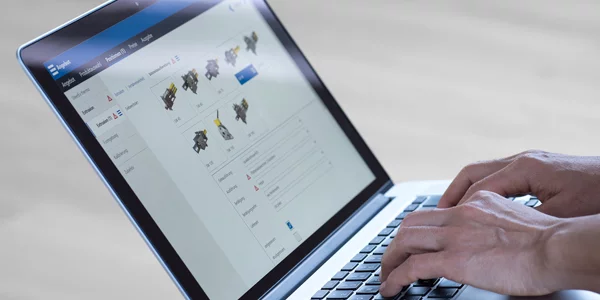The right configuration approach for complex products
Product configuration for machines and plants can be highly complex. There are two basic configuration approaches to manage the resulting diversity. However, only a comprehensible and user-friendly approach is of any practical use.
The competitive factor of individualisation in machine and plant construction
Meeting customer-specific requirements has always been an important competitive factor in European mechanical and plant engineering. In practice, this leads to a large range of variants that on the one hand are offered by the sales team and on the other require batch sizes of one during production. Solutions are therefore required that can be used to economically control the range of variants. One solution is to modularise products and facilities. Variants are achieved by intelligently configuring standardised components or modules. A well-designed modular product system can produce a large number of variants with a “manageable” number of components, without the need for special custom designs.
Complexity of product configuration for machines and plants
Despite consistent modularisation, a correspondingly complex product, such as those usually encountered in mechanical engineering, has a very large number of possible components and features, and a resulting theoretically calculable variety of up to several billion variants. We are not referring to variants that are described in parts lists at the article level but sales variants that contain customer-relevant functions with their possible characteristics. This wide range makes product configuration no small task. Furthermore, the interdependence of components, features and characteristics described in rules must be taken into account during configuration: e.g. component Kx is only permissible if feature Ma > value1; or if component A is selected, component B must also be selected or even added automatically. The rules are derived from various sources, such as legal regulations, technical, physical or constructional constraints, marketing and sales strategies, or country-specific features.
Mastering diversity with CPQ systems and product configurators
To master this range of variants and the often extensive set of rules in sales, CPQ systems (configure, price, quote), and in particular the product configurators contained in them, are now used. Product configurators help the user to only select valid combinations and thus arrive at a buildable product that best meets their requirements. The user may be a sales representative, dealer or the customer himself. In order to configure products intelligently, the CPQ systems are based on product models that describe the products, functions, features, characteristics and their object dependencies. The various CPQ systems differ fundamentally from one another.
The variant management approach
Some systems rely on variant management, in which all possible variants, i.e. all permitted combinations of functions and characteristics, are shown in a table. A suitable variant is then selected during the configuration process, or suggested according to the customer’s requirements.
In machine and plant engineering, however, the variant management approach described above comes up against its limits because not all variants can be defined in advance in a closed modular system. Customer requirements that deviate from the standard and must be clarified in engineering must regularly be taken into account. In this context, the workflow mechanisms of the CPQ system are also important in order to manually release items that are not covered by the master data or the rules of the product model.
The expert system approach
Other CPQ systems are based on an expert system approach. In this approach, the vast number of variants are not created in advance. Rather, the individual and technically feasible product is created step by step in the configuration process, taking into account the stored rules. The configuration model contains the data about the possible products, components, features and the configuration rules. The rules determine which components, features and attributes are (still) possible. These are then either automatically assigned by the system or can be selected by the user. Rule-compliant configuration is ensured or rule violations are clearly displayed with a corresponding explanation so that they can be resolved by users. This approach is very user-friendly, especially for products that are created in dialogue with the customer.
Engineering-to-order requires an expert system approach
Since configuration is carried out step by step, this model works very well even with very large system configurations – i.e. for interactions between several individual products and complete systems. This type of configuration also allows free manual positions that are not provided in the configurator but are required for a particular customer request to be inserted at any point. Particularly in engineer to order (ETO), the use of free positions is essential.
Step-by-step configuration process
The aim of this expert system approach is not to find a valid configuration as automatically as possible, as is the case for systems with a constraint solver or variant tables. Rather, the configuration is built step-by-step on the basis of templates and pre-settings. The decision-making competence of the salesperson and/or the customer is deliberately used to select a possible variant from the selection still available for a function or component. It may be that the desired selection is no longer permissible due to previous decisions. In such case, the configurator supports the user in going back in the process and changing the earlier decision.
This backtracking will be largely avoided if the user first selects the components that are important to him or if these decisions are displayed with priority in a guided dialogue (guided selling). This is also a very intuitive process. Nobody would configure their car around the ashtray, but rather would primarily focus, say, on the body, engine, etc.
Easy maintenance of the product models through rules
The expert system approach also enables the maintenance of the product models with minimal effort. Since the product model does not consist of innumerable variants, as these only arise in the configuration process, only the rules and master data stored need to be maintained or supplemented. Furthermore, experience shows that rules are subject to fewer changes. The structure of the product models, which is stored in the configuration knowledge base, is usually very constant for existing products. Only the specific characteristics of components and features are changed on a regular basis. With skilful integration into an ERP or PLM system, these are automatically taken into account as configurable material in the product model.
In addition, expert system-based configuration does not directly create relationships between material items, but rather uses rules and constraints to create relationships between classifying characteristics. The concrete material itself is determined using a classification system applied to the characteristics thus defined. Thus there is only a loose dependency between the knowledge base on the one hand and the master data on the other. This considerably reduces the effort required to maintain the product models.
Summary: Expert system based configuration for complex products
The expert system approach thus promises a much more comprehensible and therefore user-friendly procedure for the configuration of complex products, plants or systems, and easier maintenance of the product models for the product manager.
Whitepaper: Future of B2B Sales
In this free whitepaper you will learn:
1. How purchasing behavior for industrial products is changing.
2. What the key challenges for the digitalisation of B2B sales are.
3. How these challenges can be solved with CPQ.
You will be introduced to the fields of action for the digitalisation of B2B sales:
1. Provide relevant information at the right time.
2. Convince emotionally in a digital environment.
3. Ensure a consistent user experience across all channels.
4. Achieve a competitive advantage with short reaction times.

